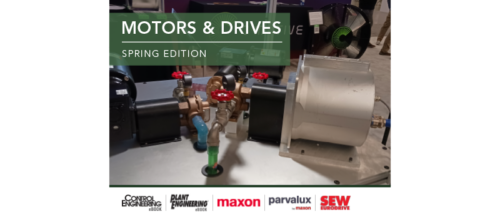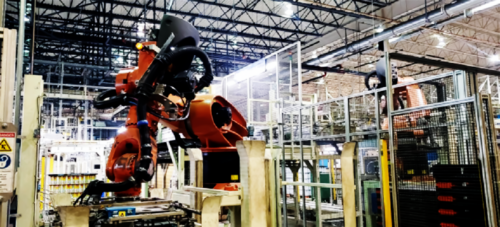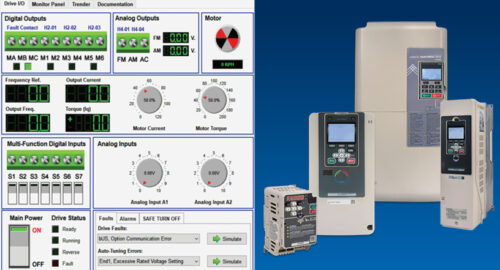Report from Hannover, Daily Innovation Focus: explosion-proof sensors, efficiency certification
This daily report from Hannover Fair focuses on explosion-proof sensors, zero-defect strategies, TUV energy efficiency certification, hazardous environment coils, and three-in-one servo drives. See photos and related links.
Hannover, Germany – In this daily report from Hannover Fair, we focus on developing projects and technologies of particular interest to the Control Engineering audience. This report focuses on explosion-proof sensors, zero-defect strategies, TÜV energy efficiency certification, hazardous environment coils, and three-in-one servo drives.
Three-in-one servo drive
Parker Hannifin introduced TPD-M servo drive, which combines three servo power stages in a single compact unit. The new compact drive has been developed for applications where multiple drives are normally used.
By replacing up to three individual drives with a single TPD-M unit, Parker Hannifin notes that space and weight in control cabinets are reduced as well as component costs—as only one set of drive parts, cables, connectors, filters and braking resistors are required. Parker Hannifin also claims that, with system complexity minimized, safety and maintenance, as well as programming requirements, are reduced.
The TPD-M servo drives are available in one-, two- or three-axis versions, the latter offering CANopen and EtherCat interfaces. The drives also feature integrated “Safe Stop” functionality in accordance with EN954-1.
www.parker.com
Explosion-proof position sensor
Temposonics R and G Series absolute linear position sensors from MTS are available for installation in hazardous areas. These non-contact, wear-free sensors are reportedly suitable for use in potentially explosive atmospheres containing flammable gases (Groups IIA, IIB and IIC) and dusts. According to MTS, the sensors have been certified to be in compliance with the European ATEX directive 94/9/EC, meaning that they meet the requirements of instrument categories 3D (Zone 2) and 3G (Zone 22).
| Control Engineering editorial director David Greenfield, Consulting-Specifying Engineer editor Michael Ivanovich, and Plant Engineering editor Bob Vavra will be reporting from Hannover Messe this week on the new ideas and new technologies from the 2009 event. Monday – Flying penguin, innovations, efficiency – Phoenix Contact shows new networking, safety relay, junction box – Report from Hannover: Daily Innovation Focus Tuesday – Wind in the sails for Hermes Award winner – Looking for an attendance bump at Hannover Fair – Voice of youth at Hannover Fair Wednesday – Buzzwords include ‘Pleasantly surprised’ – Product focus is on innovation, energy, says Siemens executive – Daily Innovation Focus: sensors, Ethernet switches, safety, controllers – World Energy Dialogue says lead environmentally to succeed Thursday – New SEW system designer packages, stainless steel gear motor |
The transducers are available with rod or profile-shaped housings and analog, CAN, SSI or start/stop interfaces. Maximum surface temperature is specified as 135 °C in a gas-containing atmosphere and 100 °C if dust is present. The IP67-rated housing protects the sensors against dust and water.
www.mtssensor.com
TÜV energy efficiency certificate
TÜV SÜD’s exhibit at Hannover Messe focused on the introduction of its newly developed “Energy-Efficient Systems and Installations” certificate. This new certificate adds a key component to the range of energy-efficiency services offered by the company.
“Plant producers that deliberately focus on energy efficiency when designing their systems will now be able to provide their customers with convincing documentation of their efforts,” says Frank Schröter from the Energy Systems Department at TÜV SÜD Industrie Service GmbH in Dresden. “In the certification process, our experts assess the energy efficiency and the extent of potential savings generated by new plants and systems. They compare the current status with the potential savings resulting when the technology in use undergoes optimization.”
During this process, not only the plant’s technical components must demonstrate their energy efficiency, but TÜV SÜD’s experts also investigate whether the plants continue to be energy-efficient in later operation by monitoring a range of different operational statuses and modes of operation. The assessment incorporates the technical and economic framework conditions and costs throughout the plant’s entire life cycle. TUV Rheinland appraises, tests and certifies technical equipment and products according to international quality standards and then registers those in compliance.
www.tuv.com
Zero-defect strategy via acoustic emission
Exhibitors from the Institute of Metal Forming and Metal Forming Machines (IFUM) at the Leibniz University in Hannover introduced their concept of a forging support system based on acoustic emission as an online monitoring and analysis technique. This “zero-defect strategy” as a quality concept is said to be being increasingly applied in forging industries, especially during the manufacturing of safety components for the automobile or aerospace industries.
Over the last few decades, according to the IFUM, acoustic emission has proved its strength and reliability as an online monitoring technique, by demonstrating a high degree of reliability in characterizing various phenomena related to material deformation and phase transformation, as well as crack initiation and propagation at different scales. In the research project presented at Hannover Fair, a diagnosis module combines different acoustic emission analysis, along with clustering and pattern recognition methods, to make inferences about different types of damage or failures taking place during the forging operation.
www.ifum.uni-hannover.de
Hazardous environment coils
Parker Hannifin launched new ATEX certified 37 mm electrical coils for use on its Lucifer range of stainless steel solenoid valves, as well as the brass and aluminum X valves. These coils were developed to broaden the usability of Parker Hannifin valves in the oil and gas, chemical, and pharmaceutical markets.
The coils are also IEC EX certified, and are dedicated to stainless steel 2/2 and 3/2 valves, as well as 4/2 and 5/2-way valves. The coils meet T6 temperature classes, and the stainless steel fittings are IP67 rated.
www.parker.com
– David Greenfield, editorial director, Control Engineering ; edited by Mark T. Hoske, editor in chief. Register here .
Do you have experience and expertise with the topics mentioned in this content? You should consider contributing to our CFE Media editorial team and getting the recognition you and your company deserve. Click here to start this process.





